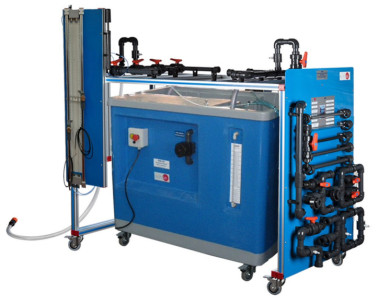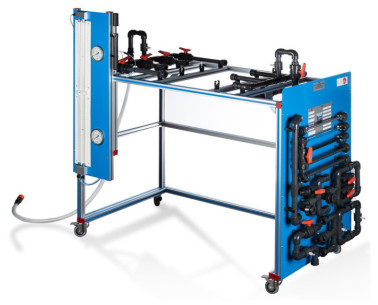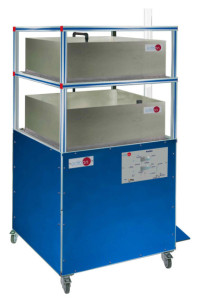HECA 気流学習実験装置
革新的なシステム
The Air Flow Studies Unit, "HECA", allows to study the basic principles of fluid mechanics that are applied to analyze the air flow in orderto determine the pressure distribution and the velocity profile of a flow.
研究室
関連ニュース
概要
The Air Flow Studies Unit, "HECA", is a floor standing unit that allows to measure different characteristics of air distribution systems and to demonstrate certain basic principles of fluid mechanics in ducts and jets.
The unit is mounted on a metal frame with wheels and consists of two modules connected one to each other.
One module includes an electrical centrifugal fan, with speed control.
The other module includes a long and smooth test pipe that is connected to the suction side of the centrifugal fan. A deflector in the inlet prevents air separation from the wall of the pipe and reduce the formation of vortices, and the pipe diameter minimizes the presence of turbulence. Several pressure tappings are included along the length of the pipe to determine the pipe friction factor, pressure losses and velocity profiles.
The unit has two Pitot tubes:
- One located at the discharge of the fan, attached and properly protected. It can be situated at different distances from the discharge orifice to study free jet velocity profiles.
- The other one can be located in any of the different points of the test tube to perform an air flow analysis of the velocity profile inside the pipe section. This Pitot tube can also be located at different distances in the pipe to demonstrate the boundary layer growth.
The air flow rate can be measured with various measuring devices, such as iris diaphragm, a Pitot tube, an orifice plate and two nozzles with different diameters.
The unit includes two bends and an angle to fit to the pipe for comparison of pressure losses.
The measuring devices and the Pitot tubes are connected via tubes to a multi-tube inclinable manometer where the pressure differences can be measured. This manometer can be inclined to increase its resolution and can be locked into different positions.
演習と指導の慣行
マニュアルに含まれるガイド付き実習
- Utilization of manometers to measure pressure drops.
- Measurement of air flow rate with an iris diaphragm.
- Measurement of air flow rate with a Pitot tube.
- Measurement of air flow rate with an orifice plate.
- Measurement of air flow rate with a nozzle.
- Determination of pressure losses in straight pipes.
- Determination of pressure losses in pipe bends and angles.
- Determination of the velocity profile in a pipe which air is flowing.
- Determination of the velocity profile in a free jet with the Pitot tube.
- Demonstration of the boundary layer growth.
- Understanding the use of Reynolds’ numbers.
- Measuring the air flow via a Venturi nozzle (requires the additional recommended element HECA-1).
- Determination of the exact section of the Venturi tube. Study of Bernoulli’s Theorem (requires the additional recommended element HECA-1).
- Study of the velocity profile above a flat plate (requires the optional accessory HECA-2).
- Study of the boundary layer on a flat plate (requires the additional recommended element HECA-2).
- Study of the drag forces in different shapes. (requires the additional recommended element HECA-3).
補完的な機器
導管内流体摩擦実験装置(水圧ベンチFME00付)
導管内流体摩擦実験装置(基本水圧供給システムFME00/B付)
導管内流体摩擦実験装置
コンピューター制御導管ネットワーク装置(水力学ベンチFME00付)
導管ネットワーク設備(水力学ベンチFME00付)
導管ネットワーク設備(水力学ベンチFME00なし)
Mesh in Pipe Unit
Unit to Study the Pressure Drop of Compressible Fluids in Pipes
コンピューター制御水撃実験装置
コンピューター制御圧縮流体流動実験装置
貯水槽における一時流動排水プロセス コンピューター制御実験装置
品質

アフターサービス

 クッキーの設定
クッキーの設定
















